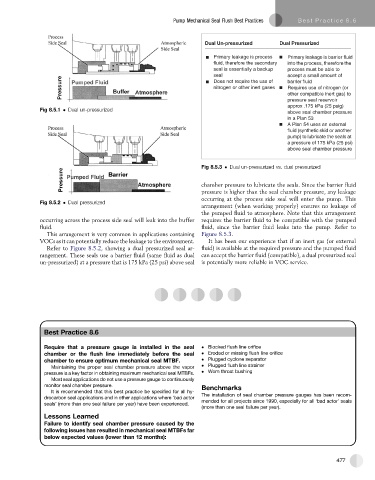Page 506 - Subyek Teknik Mesin - Forsthoffers Best Practice Handbook for Rotating Machinery by William E Forsthoffer
P. 506
Pump Mechanical Seal Flush Best Practices Be st Practice 8.6
Dual Un-pressurized Dual Pressurized
Primary leakage is process Primary leakage is barrier fluid
fluid, therefore the secondary into the process, therefore the
seal is essentially a backup process must be able to
seal accept a small amount of
Does not require the use of barrier fluid
nitrogen or other inert gases Requires use of nitrogen (or
other compatible inert gas) to
pressure seal reservoir
approx .175 kPa (25 psig)
Fig 8.5.1 Dual un-pressurized
above seal chamber pressure
in a Plan 53
A Plan 54 uses an external
fluid (synthetic skid or another
pump) to lubricate the seals at
a pressure of 175 kPa (25 psi)
above seal chamber pressure
Fig 8.5.3 Dual un-pressurized vs. dual pressurized
chamber pressure to lubricate the seals. Since the barrier fluid
pressure is higher than the seal chamber pressure, any leakage
occurring at the process side seal will enter the pump. This
Fig 8.5.2 Dual pressurized
arrangement (when working properly) ensures no leakage of
the pumped fluid to atmosphere. Note that this arrangement
occurring across the process side seal will leak into the buffer requires the barrier fluid to be compatible with the pumped
fluid. fluid, since the barrier fluid leaks into the pump. Refer to
This arrangement is very common in applications containing Figure 8.5.3.
VOCs as it can potentially reduce the leakage to the environment. It has been our experience that if an inert gas (or external
Refer to Figure 8.5.2, showing a dual pressurized seal ar- fluid) is available at the required pressure and the pumped fluid
rangement. These seals use a barrier fluid (same fluid as dual can accept the barrier fluid (compatible), a dual pressurized seal
un-pressurized) at a pressure that is 175 kPa (25 psi) above seal is potentially more reliable in VOC service.
Best Practice 8.6Practice 8.6
Best
Require that a pressure gauge is installed in the seal Blocked flush line orifice
chamber or the flush line immediately before the seal Eroded or missing flush line orifice
chamber to ensure optimum mechanical seal MTBF. Plugged cyclone separator
Maintaining the proper seal chamber pressure above the vapor Plugged flush line strainer
pressure is a key factor in obtaining maximum mechanical seal MTBFs. Worn throat bushing
Most seal applications do not use a pressure gauge to continuously
monitor seal chamber pressure. Benchmarks
It is recommended that this best practice be specified for all hy-
The installation of seal chamber pressure gauges has been recom-
drocarbon seal applications and in other applications where ‘bad actor
mended for all projects since 1990, especially for all ‘bad actor’ seals
seals’ (more than one seal failure per year) have been experienced.
(more than one seal failure per year).
Lessons Learned
Failure to identify seal chamber pressure caused by the
following issues has resulted in mechanical seal MTBFs far
below expected values (lower than 12 months):
477

